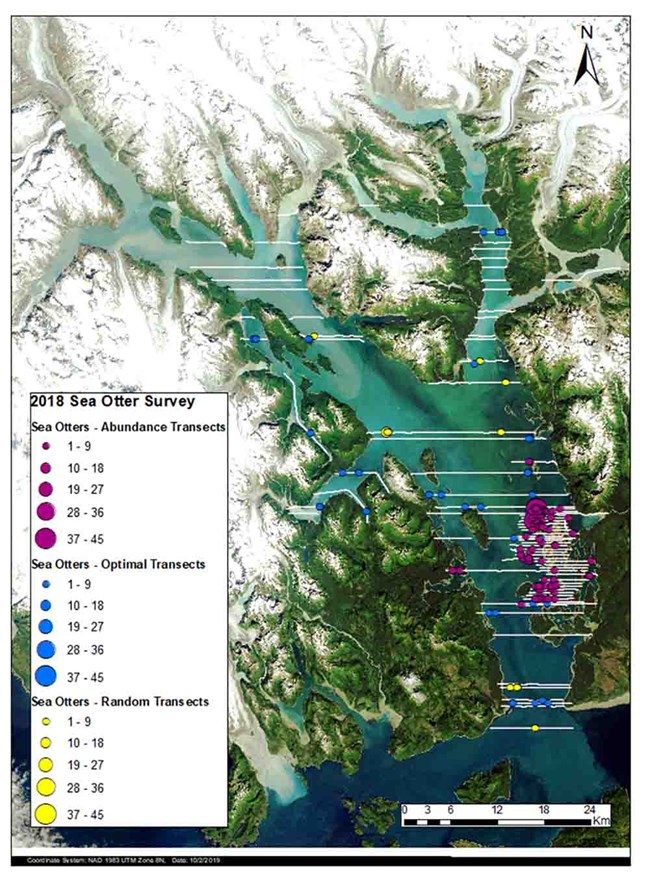Last updated: July 15, 2020
Article
Sea Otters: A Keystone Species in Glacier Bay

NPS/Jamie N. Womble
Sea otters (Enhydra lutris kenyoni) are a keystone species in the North Pacific Ocean that structure the nearshore ecosystem. Sea otters represent an incredible story of conservation, resilience, and change. Prior to 1900, sea otters were exploited by the commercial fur trade and were almost extirpated throughout much of their range from California to Alaska. In the 1960s, around 400 sea otters were translocated from sites in the Aleutian Islands and Prince William Sound to the outer coast of southeastern Alaska. Sea otters were documented in Glacier Bay in the late 1980s and since that time they have increased dramatically and are currently the most abundant marine mammal in the bay. Sea otters are monitored in the Glacier Bay marine ecosystem because of their role as a keystone species in the nearshore food web.

Methods
From 1992-2012, sea otters were monitored in Glacier Bay using observer-based aerial surveys that were conducted by the US Geological Survey (Esslinger et al. 2015 and 2019). Beginning in 2017, the National Park Service developed aerial photographic methods and a contemporary analytical framework to monitor sea otter abundance and spatial distribution (Williams et al. 2017, Womble et al. 2018). Aerial surveys are flown along systematic transects across Glacier Bay (Figure 1) and a camera takes digital images (Figure 2) of otters directly beneath the airplane (Womble et al. 2020). The aerial photographs provide a permanent record of sea otter numbers and distribution. Sea otters in the photos are counted and models are used to estimate abundance.

NPS/Jamie N. Womble
Results
Estimates of sea otter abundance in Glacier Bay have increased substantially since the early 1990s and recent surveys have estimated around 8,000 sea otters in Glacier Bay (Figure 3; Lu et al. 2019). Since the 1990s, the population of sea otters in Glacier Bay has grown exponentially, which was likely driven by both intrinsic population growth as well as immigration from outside of Glacier Bay (Williams et al. 2019). We are currently developing an integrated model of the nearshore benthic food web to more fully understand the factors that influence sea otter population dynamics and the role that sea otters play in influencing community structure. The study of sea otter colonization in Glacier Bay provides important insight into the ability of a species to recover from near extirpation and to understanding their role in structuring the nearshore food web in Glacier Bay.

Literature Cited
Esslinger, G. G., D. Esler, S. Howlin, and L. A. Starcevich. 2015. Monitoring population status of sea otters (Enhydra lutris) in Glacier Bay National Park and Preserve, Alaska - Options and considerations. USGS Open-File Report 2015-1119, 42 pp.
Esslinger, G. G. 2019. Sea otter aerial survey data from Glacier Bay National Park and Preserve, 1999-2012: U.S. Geological Survey data release.
Lu, X., P. J. Williams, M. B. Hooten, J. A. Powell, J. N. Womble, and M. R. Bower. 2019. Nonlinear reaction-diffusion process models improve inference for population dynamics. Environmetrics 31(3): e2604.
Williams, P. J., M. B.Hooten, J. N. Womble, G. G. Esslinger, M. R. Bower, and T. J. Hefley. 2017. An integrated data model to estimate spatio-temporal occupancy, abundance, and colonization dynamics. Ecology 98: 328-336.
Williams, P. J., M. B. Hooten, G. G. Esslinger, J. N. Womble, J. L. Bodkin, and M. R. Bower. 2019. The rise of an apex predator following deglaciation. Diversity and Distributions 25: 895-908.
Womble, J. N., P. J. Williams, W. F. Johnson, L. F. Taylor-Thomas, and M. R. Bower. 2018. Sea Otter Monitoring Protocol for Glacier Bay National Park, Alaska Version SO-2017.1. NPS/SEAN/NRR—2018/1962. National Park Service, Fort Collins, Colorado.
Womble, J. N., P. J. Williams, X. Lu, L. F. Taylor, and G. G. Esslinger. 2020. Spatio-temporal abundance of sea otters in Glacier Bay National Park from 1993 to 2018. NPS/SEAN/NRDS2020/1283. National Park Service. Fort Collins, Colorado.
